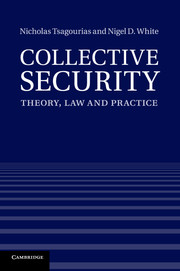
-
Select format
-
- Publisher:
- Cambridge University Press
- Publication date:
- November 2013
- October 2013
- ISBN:
- 9781139058506
- 9781107015401
- 9781316603468
- Dimensions:
- (228 x 152 mm)
- Weight & Pages:
- 0.95kg, 518 Pages
- Dimensions:
- (229 x 152 mm)
- Weight & Pages:
- 0.8kg, 518 Pages
You may already have access via personal or institutional login
Book description
This analysis of collective security covers its institutional, operational and legal parameters along with the United Nations system, presenting it as a global public order institution for maintaining peace. The authors study its constitutional premises as they are shaped by the forces of law and politics. After an historical account of initiatives and projects for global peace, the authors explain the morphology of collective security as a global public order institution and outline its triggers, institutions, actors, components and tools. They go on to analyse its legal properties and the processes of political, legal and criminal accountability. The analysis and assessment are informed throughout by practice drawn from examples including Korea, Iraq and Libya, and by a wealth of cases from national and international jurisdictions.
Contents
Metrics
Full text views
Full text views help Loading metrics...
Loading metrics...
* Views captured on Cambridge Core between #date#. This data will be updated every 24 hours.
Usage data cannot currently be displayed.
Accessibility standard: Unknown
Why this information is here
This section outlines the accessibility features of this content - including support for screen readers, full keyboard navigation and high-contrast display options. This may not be relevant for you.
Accessibility Information
Accessibility compliance for the PDF of this book is currently unknown and may be updated in the future.


